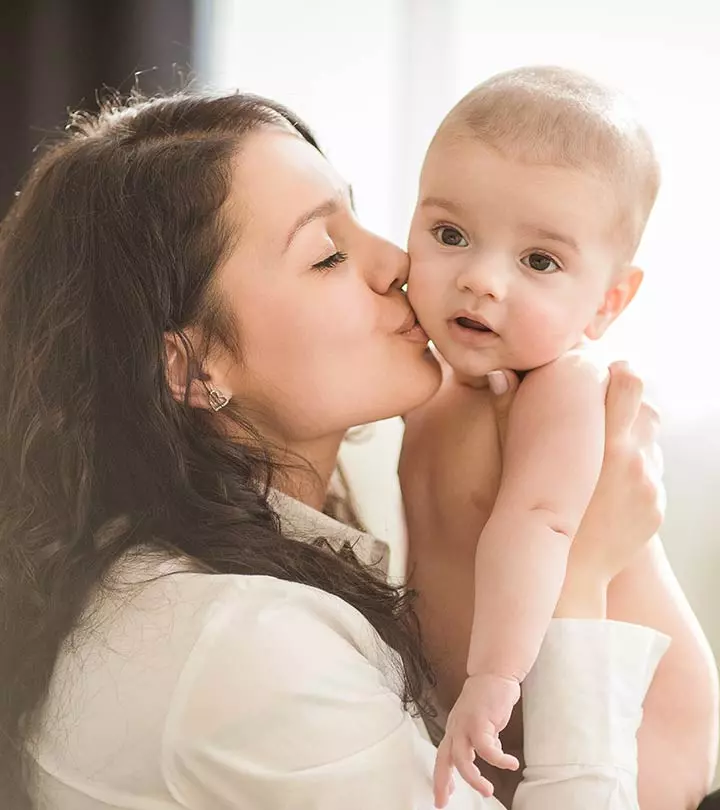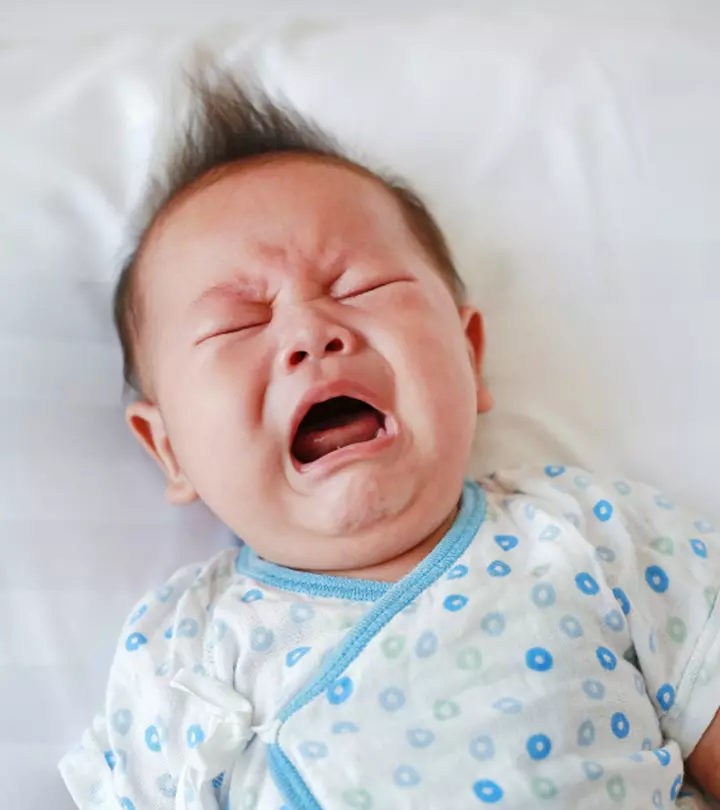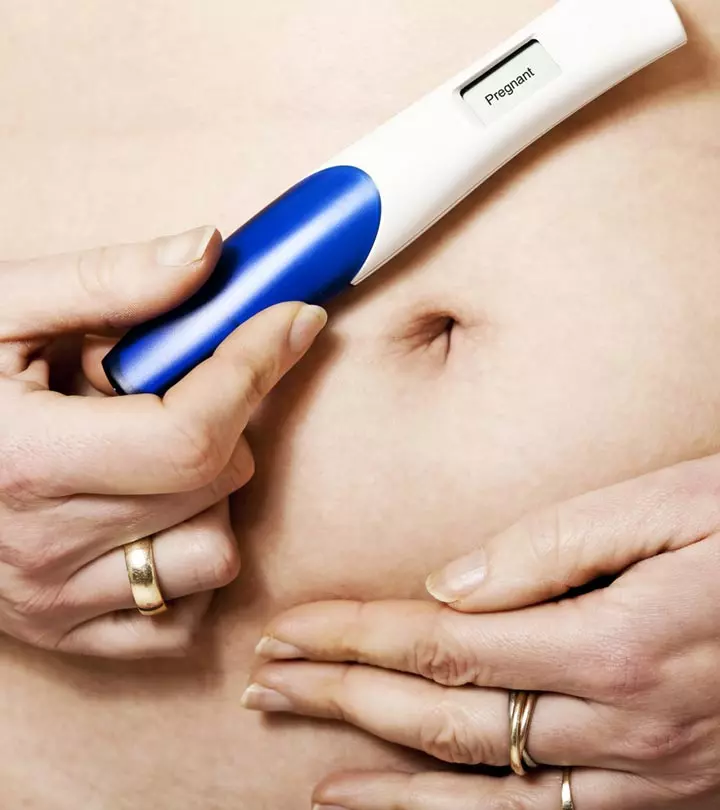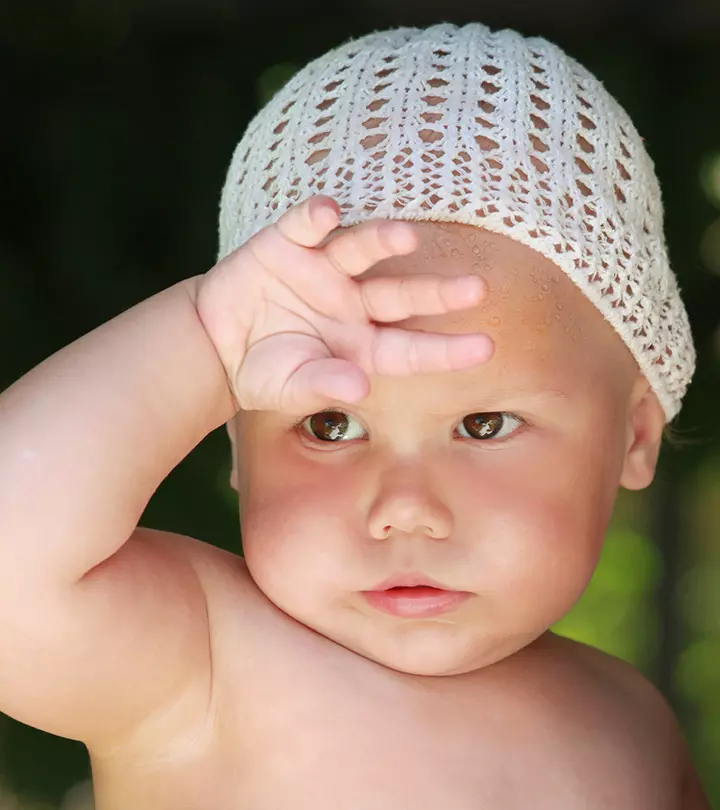
Image: ShutterStock
Excessive sweating in toddlers can be due to various reasons ranging from normal activities or climate to serious medical conditions. Hyperhidrosis is uncommon in babies and toddlers, and most of them may have underlying problems. Sweaty palms could interfere with some skill development, such as holding something in hand. Skin irritations and heat rashes from sweat may also occur if your toddler is sweating more than usual (1). It is advisable to seek medical attention to find the underlying cause. Read on to learn more about the causes, signs, types, diagnosis, and treatment of excessive sweating in toddlers.

Key Pointers
- Toddlers can sweat in hot and humid conditions, but hyperhidrosis can cause excessive sweating.
- Hyperhidrosis is a rare disorder that causes sweating on palms, soles, face, and scalp.
- Secondary hyperhidrosis causes sweating all over the body due to other underlying conditions.
- Consult a pediatrician if you notice excessive sweating on palms, soles, or face, or if clothes are soaking wet.
- Prevent excessive sweating in children by using appropriate clothing, keeping room temperature regular, and using sweat-proof outdoor clothing.
Is It Normal For A Toddler To Sweat?
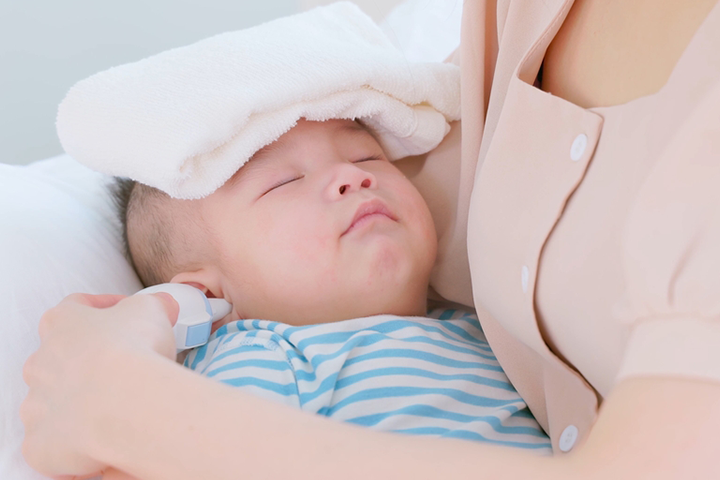
Image: Shutterstock
It is normal for your toddler to sweat in warm or humid climates, and when they indulge in physical activity. Fever, cold, and flu may also increase sweating in babies and toddlers, although that resolves after the infection. While toddlers and babies don’t sweat as much as adults do, it is normal for your baby to sweat in situations where you are also sweating.
Types Of Excessive Sweating
Hyperhidrosis or excessive sweating in toddlers can be of two types (2):
- Generalized excessive sweating is sweating all over the body, which often leaves the clothes soaked in sweat.
- Localized excessive sweating is sweating in only one part of the body, such as in the armpits, face, or neck.
Depending on the cause, hyperhidrosis can be divided into (3):
- Primary hyperhidrosis is a rare disorder that results in excessive sweating only in the armpits, palms, soles, face and scalp. Primary focal hyperhidrosis affects boys and girls equally and is prevalent among one to three percent of the pediatric population (15).
- Secondary hyperhidrosis (diaphoresis) causes generalized sweating due to underlying diseases such as thyroid disorder, infection, or medication.
 Quick fact
Quick factCauses Of Hyperhidrosis In Toddlers
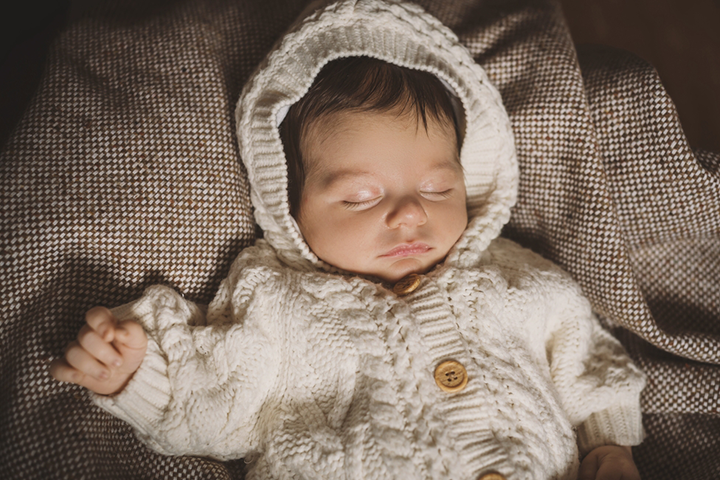
Image: Shutterstock
Though it is not normal for a toddler to sweat excessively, it often happens due to over-bundling or overdressing your child. Many parents tend to make their toddlers or babies wear more pieces of warm clothes than needed, especially during sleep time. In such cases, you will notice the toddler or baby sweating in sleep.
If you make your toddler wear warm clothes indoors and keep room heaters high, it may cause excessive sweating and increase the risk of hyperthermia due to heat exhaustion. Your child may also sweat more than usual due to certain environmental factors, anxiety or nervousness, and physical activity (4).
Some health problems that may cause hyperhidrosis in toddlers can be (5):
- Infections
- HyperthyroidismiA condition characterized by an overactive thyroid gland that produces excessive thyroid hormone
- Diabetes
- HypertensioniA chronic condition where the pressure in the blood vessels is consistently higher than 140/90 mmHg
- Congestive heart failureiA condition where the heart can not pump adequate amounts of blood to meet the body's needs
- Prescription drugs
- Other metabolic and hormonal disorders
In addition, hypothalamic injury following a traumatic brain injury may also cause hyperhidrosis, as the hypothalamus is an important regulator of thermoregulatory sweating (16). Excessive sweating is not the only symptom of the medical conditions mentioned above. Contact your pediatrician for the examination of the other signs and symptoms to identify the possible causes of hyperhidrosis in your toddler.
Signs And Symptoms Of Hyperhidrosis In Toddlers
You may notice excessive sweating in the following areas of the body (3):
- Face
- Palms or hands (palmar hyperhidrosis)
- Underarms (axillary hyperhidrosis)
- Scalp
- Feet (plantar hyperhidrosis)
- Hands
If the humidity and temperature are normal, the following can be the signs and symptoms of excessive sweating in toddlers (6):
- Sweat on the face and arms of your baby
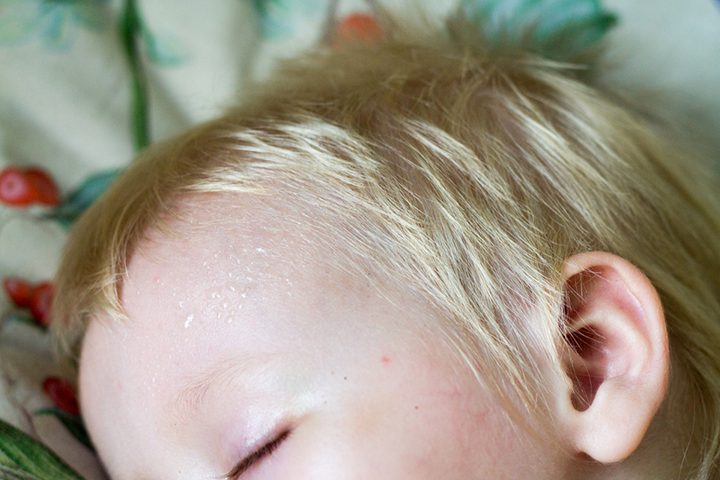
Image: Shutterstock
- Clothing is soaked in sweat
- Sweaty palms and feet
- Clammy skin or flushed skin
You may also notice that the toddler has wet palms that may interfere with their activity. These symptoms and signs can be normal if they are due to environmental factors or clothing.
 Quick fact
Quick factDiagnosis Of Hyperhidrosis In Toddlers
It is recommended that you consult a pediatrician if your toddler has excessive sweating. Excess sweating may indicate serious medical conditions in some children, although in most cases, it could be due to less worrisome causes. Only a thorough examination by the doctor can determine this.
Your doctor may evaluate the growth and development of your toddler and check if it meets the age-based requirements.
The pediatrician may also look for signs of all possible underlying causes of excessive sweating. If there is no specific medical condition contributing to sweating, your doctor may diagnose primary focal hyperhidrosis, considering the physical examination and health history (7). The diagnostic tests may include (2):
- Starch-iodine test or Minor test: It involves the application of iodine solution on sweaty areas and sprinkling starch over it. If there is sweat, this will turn into a dark blue color.
- Paper test: In this method, pre-weighed filter paper is placed under the arm for a set time. It is then reweighed to measure the sweat produced in mg per time.
- Laboratory tests: Blood and urine samples may be collected for analyzing hormonal and metabolic profiles to rule out medical conditions, causing excess sweating in toddlers.
Treatment For Excessive Sweating In Toddlers
Treatment for hyperhidrosis depends on the cause of disease. Addressing the underlying medical conditions may help resolve secondary or generalized hyperhidrosis in toddlers. Toddlers with excessive hyperhidrosis require specific treatments varying from topical creams to certain procedures.
According to the type and location of sweating, your doctor may recommend any of the following treatments for primary hyperhidrosis (7):
- Antiperspirants: They block the sweat ducts and prevent perspiration. Xerac AC and Drysol are antiperspirants commonly prescribed for children.
- Iontophoresis (no sweat machine): It is a non-painful treatment, using a medical device, commonly prescribed to treat sweaty palms.
According to Dr. Troy Reyna, a pediatric general and thoracic surgeon, “Iontophoresis is a rather unique, ingenious therapy of using an electrical current to depolarize the sweat glands and reduce the production of sweat in the axilla, hands or feet (14).”
- Anticholinergic medications: They may help to stop sweat production and improve the quality of life.
Botulinum toxin injections, surgical removal of the sweat glands, sympathectomy, and hand-held medical devices that destroy sweat glands are the effective treatments for hyperhidrosis in later ages (7) (8) (9).
If excessive sweating is not due to a medical condition, you may follow a few tips to prevent it.
 Quick fact
Quick factPrevention Of Hyperhidrosis In Toddlers

Image: Shutterstock
The following tips may help to prevent excessive sweating in your toddler (17) (18):
- Use appropriate clothing according to the climatic conditions and the environment.
- Use breathable fabrics for summer and sweatproof clothing for outdoor activity.
- Keep room temperature normal. Use air conditioning or fans to cool the room and prevent overheating.
- Serve the toddler water to ensure adequate hydration instead of sugary or caffeinated beverages.
- Check for fever and other signs of illness in the child.
- Consult your pediatrician before using natural home remedies such as apple cider vinegar, potato, cornstarch, and baking soda, as these may block the pores or cause allergic reactions.
- Follow the use of doctor-prescribed antiperspirants and dietary supplements as recommended.
Hyperhidrosis can cause a significant amount of discomfort for toddlers, making it important to identify and manage the condition early on. Keep them hydrated as sweating may lead to excessive thirst and dehydration
Frequently Asked Questions
1. Is sweating a symptom of ADHD?
Sweating is not a direct symptom of ADHD. It may be a symptom of stress and anxiety disorders which are often found to coexist in children with ADHD (11).
2. Is it normal for a baby to sweat on the head?
Babies may sweat on their heads without any concerning reason. It usually occurs as the sweat glands are first to develop on the scalp and the forehead (12).
3. When do babies start sweating?
Some studies suggest that it may take about four days to two weeks for newborns to show sweating after birth. This time is required for the development of the sweat glands (12). However, each baby is different, and the time may vary.
4. What is a sweat test for toddlers?
A sweat test helps diagnose cystic fibrosis in children, a genetic condition that affects the lungs and the digestive system. It involves collecting sweat and assessing the amount of salts (chloride) in it. Those with cystic fibrosis have a higher than normal level of salt in their sweat (13).
5. What are the long-term effects of excessive sweating in toddlers?
Prolonged hyperhidrosis in toddlers can lead to anxiety, depression, and reduced quality of life. It can disrupt daily activities like holding a pencil, playing sports, or socializing with peers. As the child grows older and becomes more aware of their symptoms, these challenges may intensify (14).
Hot and humid weather, fever, physical exertion, and wearing warm clothes can cause sweating. Excessive sweating in toddlers is considered normal in situations where you are also sweating. However, it is not normal if your toddler sweats when others are not sweating. Localized hyperhidrosis or excessive sweating can be noticed on palms, armpits, soles, or any body area, and generalized sweating is seen all over the body. Depending on the cause, excessive sweating can be primary or secondary. Usually, primary hyperhidrosis can be managed with anticholinergic or antiperspirant medications, and secondary hyperhidrosis requires treatment of underlying conditions such as hormone issues, diabetes, or infections.
Infographic: Parent’s Guide To Toddler’s Hyperhidrosis
Sweating profusely and abnormally can affect your toddler’s quality of life, making medical intervention necessary. But here are a few things you can try at home to help your little one cope with the condition. Save this infographic to keep it handy and manage your toddler’s excessive sweating to avoid discomfort. Illustration: Momjunction Design Team
Excessive sweating in toddlers may be relatively normal, yet if you are concerned you may seek a few tips from the following video to explore how to help your child manage this condition.
References
1. Should You Put Sunscreen on Infants? Not Usually; The Food and Drug Administration
2. Tanja Schlereth, et al.; HyperhidrosisCauses and Treatment of Enhanced Sweating; Deutsches Ärzteblatt International
3. Excessive sweating; The Johns Hopkins University School of Medicine
4. Hyperhidrosis (excessive sweating); SickKids
5. Hyperhidrosis of palms and soles; DermNet; New Zealand
6. Hyperhidrosis; The Children’s Hospital of Philadelphia
7. Isabelle Thomas, et al.; Palmoplantar Hyperhidrosis: A Therapeutic Challenge; The American Academy of Family Physicians
8. Amanda-Amrita D. Lakraj, et al.; Hyperhidrosis: Anatomy, Pathophysiology and Treatment with Emphasis on the Role of Botulinum Toxins; Toxins 2013
9. Hyperhidrosis: Diagnosis and treatment; The American Academy of Dermatology
10. Hyperhidrosis; Riley Hospital for Children
11. Symptoms-Attention deficit hyperactivity disorder (ADHD); National Health Services, UK
12. K. G. Foster et al., The Response Of The Sweat Glands Of The New-Born Baby To Thermal Stimuli And To Intradermal Acetylcholine; The Journal of Physiology
13. Having a sweat test; Great Ormond Street Hospital For Children
14. Diagnosis and treatment for pediatric hyperhidrosis; Children’s Hospital of Orange County (CHOC)
15. Understanding Excessive Sweating: Hyperhidrosis; The Children’s Hospital of Philadelphia
16. Sung Ho Jang and Hyeok Gyu KwonRelationship between hyperhidrosis and hypothalamic injury in patients with mild traumatic brain injury; National Library of Medicine
17. 8 Methods To Help You Stop Sweating; Cleveland Clinic(CHOC)
18. Children and Heat — Protect infants, kids, and teens; OEHHA State of California
Community Experiences
Join the conversation and become a part of our nurturing community! Share your stories, experiences, and insights to connect with fellow parents.
Read full bio of Dr. Fadel Husrom
Read full bio of Dr Bisny T. Joseph
Read full bio of Rohit Garoo
Read full bio of Shinta Liz Sunny









